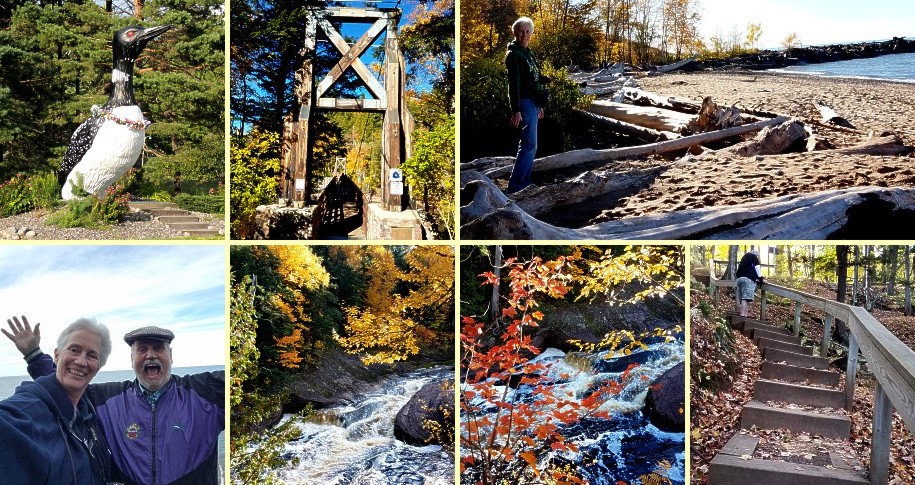Kansas Snapshots by Gloria Freeland - October 23, 2020
A Superior time
It's about 90 miles from our Northwoods Wisconsin cottage to Lake Superior - the largest of the Great lakes. I love large bodies of
water, so it makes a great day trip. Superior's large expanse and sometimes-sandy, sometimes-rocky shorelines fascinate me. It is
350 miles long and 160 miles wide with 2,730 miles of shoreline and 31,700 square miles of surface area. That makes it larger than
West Virginia and nine other states.
We've traveled the Upper-Michigan edge in past years - to Paradise, a village known for its annual blueberry festival and its
proximity to Whitefish Point, where the famed ship the Edmund Fitzgerald went down. Near Superior Falls, German "son" Tim swam in
the cold water. At Munising, Art and I boarded the "Miss Superior" for a two-hour Pictured Rocks cruise. In Marquette, there is
a huge iron-ore ship-loading dock.
Ontonagon, a harbor town that bills itself as the "gateway to the Porcupine Mountains," was again our destination on Sept. 18. The
autumn colors were just beginning to appear, which made for a pleasant drive. We drove through the town and stopped at a small
strip of rocky shoreline. It was about 55 degrees F and quite breezy. When I stepped out of the car, the chill stung my cheeks,
but not enough to deter me from getting as close as possible to the gray, choppy water. As always, I looked for unusual rocks and
driftwood to add to our cottage display collection. I love the way the wind and waves round the edges of rocks and polish wood to
a smooth gray-white sheen. We also spent a bit of time along a fairly wide strip of sandy beach, primarily watching seagulls.
That trip was nice, but the second one on Oct. 8 was nicer. We passed through several Wisconsin towns - Eagle River, Sayner,
Manitowish, and Mercer, famous for its large "Claire d'Loon" sculpture. We only stopped long enough one time to take a quick photo,
but supposedly Claire "talks" - primarily calling out in various loon cries.
Then it was Pine Lake and on to Hurley, where we stopped to take a picture of the historical museum building topped with two
copper domes.
Once into Michigan, we drove through Ironwood and Bessemer, making a mental note to explore them both someday.
From Bessemer, we turned north, skirting the Black River. It was 3 p.m. when we walked across the Suspension Bridge at the mouth
of the river where it empties into Superior. The bridge was constructed by members of Camp Norrie Civilian Conservation
Corps members in 1938-1939. There are stone supports at both ends. The steel suspension cables, steel plates and one-foot-square
timbers form the 210-foot bridge, which is designed to allow for "give-and-sway" with the wind. It also gave and swayed with
every step, producing a somewhat unfounded sense of unease.
Once on the other side, we had access to the North Country Scenic Trail and the Lake Superior Shoreline. The temperature was in
the mid-60s and the bright sunshine made the yellows, reds and oranges of the trees really "pop" against the blue sky and water.
Waves lapped gently against the sandy shore, providing "white noise" that drowned out the sounds of the few other people who had
taken advantage of the nice day. One couple gathered rocks and driftwood, putting their "treasures" in a large plastic green
bucket. Artists? Probably just people like me, who like to display them on tables and in glass jars.
Before returning to the car, we inspected the Nancy Jean, a 32-foot wooden boat, in the small park. Built in 1913 by the Dan
Kidney Boat Factory of DePere, Wisconsin, it is believed the boat worked in the commercial fishing trade until 1940 and then
worked as a charter fishing vessel until the 1950s. Abandoned, the Ottawa National Forest purchased it for $1, refurbished it
and put it on display as an example of the type of craft used in the area more than half a century ago.
There were signs for various waterfalls nearby and Art asked which one I wanted to see. I wanted to visit them all, but I knew
we had time to see only one before it got too dark. I asked Art to turn in at the Sandstone Falls sign. The small parking lot
was empty, so I knew others wouldn't be nearby. But I hesitated when I saw the sign: "Steps and trail drop sharply to the falls.
Pace yourself and avoid over exertion."
We plunged ahead, not knowing whether we'd ever be in the area again.
Once at the end of the wooden steps, Art suggested we venture onto a trail to a point where the sun would still shine on the
river in the gorge. The trail was narrow and required us to hang on to branches to make sure we wouldn't slip down the steep
slope. It was so quiet in the wooded area and I loved seeing the giant roots of the trees, the ferns, the moss and the colorful
vines winding their way up the tree trunks.
But soon we heard the roaring water and came upon breath-taking views of the falls cascading over large rocks. The exertion had
definitely been worth it. Art, who had visited a few years back, said if you are there at the right time in the fall, you can
watch lake trout attempting to climb the falls just as salmon do in the Far West.
The ascent was easier than expected, but when we arrived at the car, we were ready to just sit. The trip home in the setting sun
was quiet. But we intend to return, for we definitely had a superior time on our excursions to Lake Superior.
